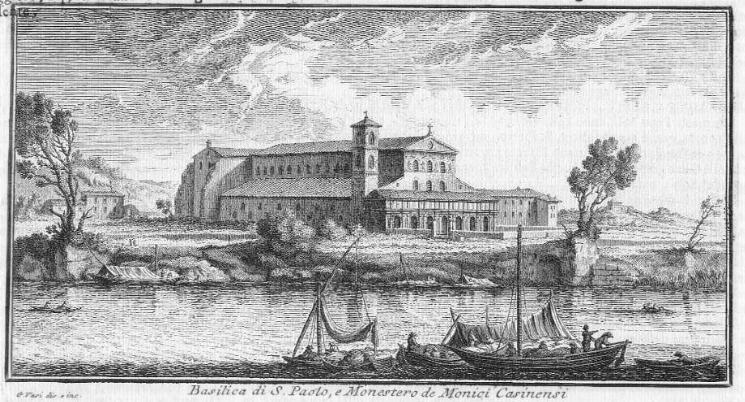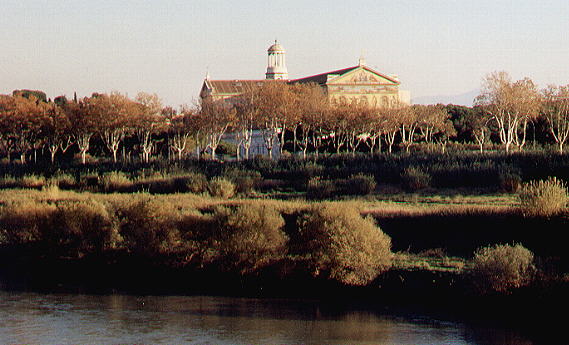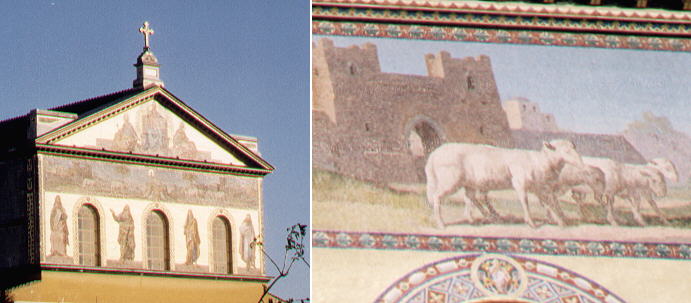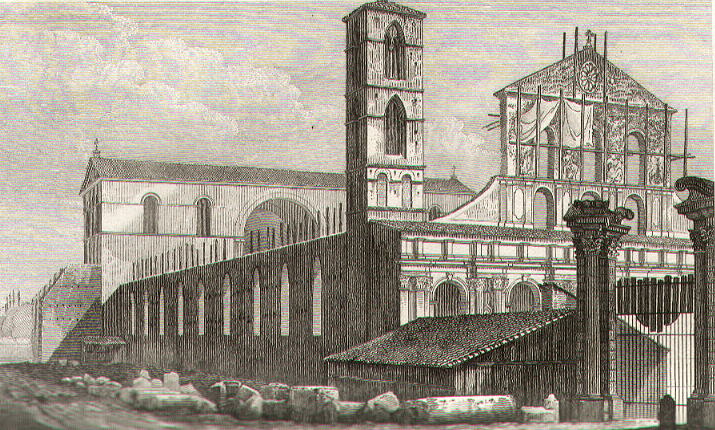

Basilica di S. Paolo (Book
5) (Day
5) (View C12)
In this page:
The plate by Giuseppe Vasi
Today's view
S. Paolo fuori le Mura
The Fire
The Plate (No. 100 - ii)
The last plate of Book V is dedicated to the Basilica di S. Paolo
seen from the river after the view from the Monastery.
Today
Although the river banks are now higher than in the XVIIIth century
they still allow a nice view of the Basilica.
Read Henry James's account of his visit to this site in 1873.
Read William Dean Howells' account of his visit to this site in 1908.
S.
Paolo fuori le
Mura
The basilica was almost entirely destroyed by fire in 1823. The bell
tower was moved to the back and a large portico was added at the entrance
of the church. The fašade was rebuilt almost entirely along the lines of
the old one. The mosaics are somewhat cold but they shine under the vivid
sun of a Roman afternoon.
The Fire
The following description of the fire is contained in Jeremiah Donovan's 1842 Rome Ancient and Modern and the image
is an illustration from the same book by Gaetano Cottafavi: "The year 1823 forms a memorable epoch in its history. Repairs were then being made
on the outside of the basilic by order of Pius VII, who had made his religious profession in the
adjoining monastery, when, very early in the morning, the whole roof was discovered to be in
flames, and soon after descended with an awful crash, carrying with it a considerable portion of
the walls, and burying in its smouldering ruins calcined pillars, detached mosaics,
paintings, and statues; and, in the short space of five hours, the work of ages was
reduced to little more than bare walls. Even the columns of porphyry, notwithstanding
their extreme hardness, were shivered to pieces; and the large bronze door of the portico
was partly melted by the violence of the conflagration. The origin of the fire remains a secret;
but the ruin which it has left serves to explain the manner in which many of the edifices of
ancient Rome fell before the same destructive element."
Excerpts from Giuseppe Vasi 1761 Itinerary related to this page:
Basilica di s. Paolo fuori delle mura
Dal Gran Costantino fu eretta questa vasta basilica ad istanza di s. Silvestro Papa in
un podere di Lucina Matrona Romana, perchŔ in esso era stato sepolto il corpo del
s. Apostolo. Dipoi fu rinnovata da Onorio Imperatore, e poi da Eudossia moglie di
Valentiniano ristaurata, ed in seguito ornata da molti Sommi Pontefici. E' formata
questa a cinque navi con 4. ordini di colonne tolte dalla mole di Adriano, oggi
Castel s. Angelo; quelle nella nave di mezzo sono di preziosi marmi, e striati, e
quelle delle navi laterali di granito; quelle per˛ della crociata sono di maravigliosa
grandezza, ed in tutto sono numero cento quaranta.
La lunghezza della chiesa senza la tribuna Ŕ di palmi trecento cinquantacinque, ed
Ŕ larga duecento tre; le tre porte sono di metallo antico, storiate, ed il gran pavimento
Ŕ tutto coperto di frammenti di marmi con varie iscrizioni antiche; il ciborio in mezzo
alla crociata Ŕ sostenuto da 4. colonne di porfido, e sotto l'altare si conserva la metÓ
de' corpi di s. Pietro, e di s. Paolo, di altri santi Martiri, e di alcuni ss. Innocenti.
Il mosaico nella tribuna fu fatto ultimamente a similitudine dell'antico,che vi era
stato fatto da Pietro Cavallini, il quale fece ancora quello sopra il portico. Il quadro,
che rappresenta la sepoltura di s. Paolo nell'altare maggiore Ŕ di Lodovico Cigoli
Fiorentino, e li quattro ovati con fatti del medesimo sono di Avanzino Nucci; le
pitture a fresco nella cappella del Santissimo sono del Lanfranco; quelle per˛ nella
volta sono di Anastasio Fiorentino. L'Assunzione della ss. Vergine nella cappella della
crociata presso la sagrestia Ŕ del Muziani, ed il martirio di s. Stefano Ŕ di Lavinia
Fontana; la conversione di s. Paolo dall'altra parte Ŕ di Orazio Gentilaschi, ed il
s. Benedetto accanto, Ŕ di Gio. de' Vecchi. Il ss. Crocifisso nella cappella, che
siegue Ŕ tenuto in somma venerazione, perchŔ si crede, che parlasse a s. Brigida, e
l'immagine della ss. Vergine, che sta da piede Ŕ quella medesima, alla cui presenza
s. Ignazio di Lojola fece la professione de' voti del suo ordine. D'intorno alla nave
di mezzo erano dipinti i ritratti de' Sommi Pontefici fino ai
tempi di s. Leone, e Benedetto XIV. feceli seguitare fino al presente.
La piccola colonna storiata, che si vede dietro della basilica vi fu posta
l'anno 1606. da Monaci Benedettini, che uffiziano la chiesa, ed occupano il celebre
monastero, giÓ abitato da s. Odone Cluniacense.
|
You have completed Book 5! Move to Book 6 - plate 101 - Battisterio Lateranense
Next plate in Day 5 itinerary: Porta
S. Paolo

Go
to  or to Book
5 or to my Home
Page on Baroque Rome or to my Home Page on Rome
in the footsteps of an XVIIIth century traveller.
or to Book
5 or to my Home
Page on Baroque Rome or to my Home Page on Rome
in the footsteps of an XVIIIth century traveller.
|






